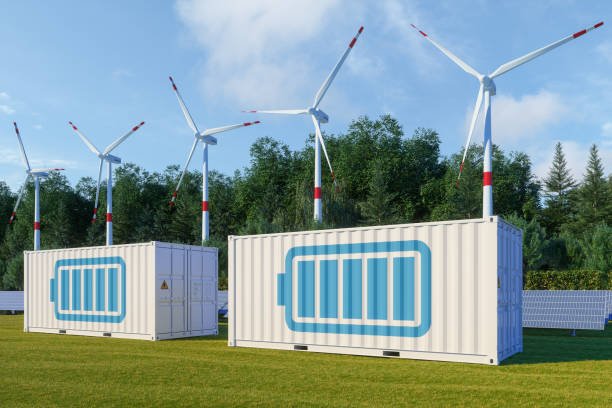As the global shift from fossil fuels to renewable energy sources accelerates, the energy storage market is positioned as a key component of this transition. The demand for effective and scalable energy storage solutions is rising, driven by the need to stabilize power grids and balance supply and demand. This market is expected to grow significantly through 2035, fueled by government policies aimed at achieving net-zero emissions and substantial investments in energy storage infrastructure.
Energy storage technologies mitigate the intermittent nature of renewable sources like solar and wind, which do not generate power consistently. These technologies store excess energy produced during peak generation times and release it when demand increases or generation decreases. Key storage technologies include: – Lithium-ion and flow batteries – Pumped hydro storage – Compressed air energy storage – Thermal energy storage – Hydrogen storage systems
These solutions cater to utilities, commercial and industrial facilities, and residential consumers for various applications, including grid balancing and backup power.
Key Drivers of Market Growth 1. **Decarbonization Policies**: Nations are phasing out coal power plants and expanding solar and wind energy capacities. The variability of renewable sources necessitates storage solutions for grid reliability. Countries like the U.S., China, and members of the EU are implementing mandates for energy storage procurement, acting as catalysts for market growth.
2. **Advancements in Battery Technology**: Innovations in lithium-iron phosphate (LFP) batteries, solid-state batteries, and long-duration storage systems are enhancing safety and reducing costs. These advancements are accelerating adoption across both utility-scale and distributed energy systems.
3. **Modernization of Power Grids**: The electrification of transportation and heating is increasing demand for reliable power grids. Energy storage systems support smart grid functionality, facilitate demand response, and alleviate infrastructure strain during peak usage.
4. **Demand for Energy Independence**: Businesses and eco-conscious consumers are investing in on-site solar and storage systems to lower energy costs and increase resilience against outages.
Market Segmentation The energy storage market segments into various categories: – **By Technology**: Electrochemical (lithium-ion, lead-acid), mechanical (pumped hydro, compressed air), thermal (molten salt), and chemical (hydrogen). – **By Application**: Residential, commercial and industrial, and utility-scale. – **By End Use**: Grid services, renewable integration, backup power, and off-grid solutions. – **By Region**: North America, Europe, Asia Pacific, Middle East and Africa, and Latin America.
Regional Insights – **North America**: The U.S. leads in large-scale storage projects, bolstered by supportive policies like the Inflation Reduction Act. California and Texas are major hubs, while Canada is investing in hydro storage systems. – **Europe**: Germany, the UK, and Spain are leaders in solar and storage integration. The EU’s Green Deal and energy independence focus post-Russia-Ukraine war have propelled investments. – **Asia Pacific**: China dominates global battery manufacturing and deployment, while India, South Korea, and Japan are increasing storage capacities to meet their renewable energy targets.
Emerging Trends 1. **Long-Duration Energy Storage**: Technologies like iron-air and zinc-based batteries are developing to provide storage for over 10 hours, crucial for seasonal energy needs. 2. **Hydrogen Utilization**: Excess renewable energy is used to produce green hydrogen, which can be stored and converted back to electricity or used in various applications. 3. **AI and IoT Integration**: Energy storage systems are becoming smarter through AI-driven analytics and remote monitoring, enhancing performance and return on investment. 4. **Second-Life Battery Usage**: Repurposing electric vehicle batteries for stationary storage is gaining traction, lowering costs and minimizing environmental impacts.
Market Challenges Despite its promising growth, the energy storage market faces several challenges: – High initial costs deter many potential buyers, especially in developing regions. – Safety concerns, particularly related to lithium-ion systems, can hinder deployment. – Regulatory uncertainties and varying grid rules across different regions create fragmentation in the market. – Sourcing materials for batteries raises environmental and ethical concerns, prompting a push for sustainable alternatives.
Competitive Landscape The energy storage market is evolving swiftly, with leading players including Tesla Energy, LG Energy Solution, BYD, Fluence, and Siemens Energy. These companies are focusing on cost reduction, safety improvements, and scalability while forming partnerships with utilities and technology firms.
Future Outlook The global energy storage market is projected to grow to between $250 billion and $300 billion by 2035, with a compound annual growth rate (CAGR) of 18% to 22%, depending on policy implementation and technological advancements. While utility-scale projects will remain prevalent, distributed energy storage systems are expected to grow rapidly as home and vehicle electrification increases. Emerging innovations in long-duration energy storage, vehicle-to-grid systems, and integrated microgrids will further shape the energy storage landscape, reinforcing its role in developing a clean and reliable energy future.



